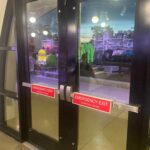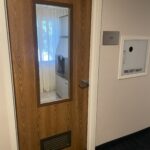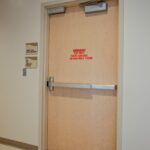Visit the CONSTRUCT blog for posts from me and other industry bloggers!
A few weeks ago I attended a presentation on accessibility standards at my local CSI chapter meeting. The meeting was very well attended, as are many of the other code classes that I’ve been to or taught. As specifiers, we need to stay current on the code requirements, to help avoid costly mistakes and ensure the safety and accessibility of the projects we are working on. I appreciate having this education available through my CSI chapter and also at the CONSTRUCT show.
In case your chapter hasn’t had a presentation on codes for door openings lately, I thought a checklist of recent changes might help. If you are already aware of everything on the list, you get a gold star!
- The 2013 edition of NFPA 80 – Standard for Fire Doors and Other Opening Protectives requires fire door assemblies to be inspected after installation (as well as annually). This is very beneficial to the building owner, because it will ensure that the doors, frames, and hardware are installed correctly. Does your specification include provisions for this initial inspection?
- The International Building Code (IBC) requires positive pressure testing for fire doors. Two types of wood doors are available – Category A, which have internal intumescent if needed, and Category B, which require field-applied intumescent. Which type of doors does your wood door spec call for?
- Doors in a means of egress are typically required to unlatch with one operation, but the 2009 edition of the IBC was modified to allow manual flush bolts on non-fire-rated pairs in certain occupancy conditions. Do you know where manual flush bolts can be used? Or where they are prohibited?
- With the 2006 edition of the IBC, the required locations for panic hardware were changed from doors serving Assembly and Educational occupancies with a load of 100 occupants or more, to these occupancy types with 50 people or more. This means that rooms half the size now require panic hardware compared to previous editions of the code.
- NFPA 70 – The National Electric Code requires panic hardware for some rooms housing electrical equipment, and there are changes and clarifications in the 2014 edition. Do your hardware sets include panic hardware on these rooms?
- Glazing used in fire doors was once exempt from the impact-resistance requirements, but those exceptions have been removed from the IBC. Your specifications should no longer include traditional wired glass, as all glazing materials used in doors, sidelites, and other hazardous locations must now meet the standards for impact-resistance.
- ANSI/BHMA A156.19 – Power Assist & Low Energy Power Operated Doors – the standard for low-energy automatic operators, now requires the automatic operation to be initiated by a “knowing act” (push button, access control reader, pushing/pulling the door). If a motion sensor is used to actuate a low-energy operator, the requirements of ANSI/BHMA A156.10 must be followed, including safety mats and guide rails.
- The 2010 ADA Standards for Accessible Design went into effect in March of 2012, and while the standards are now more closely aligned with ICC A117.1 – Accessible and Usable Buildings and Facilities, there are a couple of notable exceptions:
- Doors with automatic operators must either meet the egress-side maneuvering clearance requirements in a power-off condition, or stand-by power must be provided for the operator.
- Door hardware has been included along with controls like light switches, faucets, and elevator buttons in the requirement to operate with 5 pounds of force or less. This is a problem for the door hardware industry, especially for panic hardware which by all other codes and standards must operate with a maximum force of 15 pounds.
- Another change that was previously included in A117.1 but has now been added to the ADA is for manual doors to have a flush area with no projections on the push side of the door, from the floor to 10 inches above. This affects narrow bottom rails, as well as projecting hardware such as surface-mounted vertical rod panic hardware.
- There have been quite a few recent code changes pertaining to electrified hardware and access control:
- Sections added to the 2009 editions of the IBC and NFPA 101 – The Life Safety Code address doors with electromagnetic locks that are released by door-mounted hardware instead of a sensor and push button.
- A section added to NFPA 101 provides an alternative for locking elevator lobbies, but the IBC does not currently contain a similar section.
- The IBC and NFPA 101 now more clearly address allowable methods for locking some types of units within hospitals and nursing homes.
- The requirements for stairwell reentry (fail-safe locks on stair doors) differ between the IBC and NFPA 101. The IBC does not allow mechanically-locked levers on the stair side of the door, regardless of how many floors are being served by the stair.
If you have questions about any of these changes, you can check out the linked articles on iDigHardware.com, and/or attend my upcoming CSI webinar (watch CSI Weekly for the date!). And of course you can contact me any time at my new email address…lori.greene@allegion.com.
You need to login or register to bookmark/favorite this content.






Good end of year checklist.
Thank You for your year of very useful and thought provoking Blog entries.
Thanks Charlie! Happy New Year!
Thanks again for 2013, and what is to come in 2014
“””””With the 2006 edition of the IBC, the required locations for panic hardware were changed from doors serving Assembly and Educational occupancies with a load of 100 occupants or more, to these occupancy types with 50 people or more. This means that rooms half the size now require panic hardware compared to previous editions of the code.””””””””””
the fifty number also matches when doors have to swing in direction of travel. Which had been in previous edtions of the IBC
You’re right – although not every door that has to swing in the direction of egress needs panic hardware. I like consistency.
Thanks, Lori! Very helpful to see a concise collection of all these changes. Out here in IBC land, it especially helps to read what’s happening in NFPA 101 and get some perspective of the code environment in other parts of the country. 2014 is going to be an interesting year for enforcement and our efforts to comply. Thanks for being there and for all your hard work!
Thank you my friend…I thought you lived in CBC land. Did you relocate? 🙂